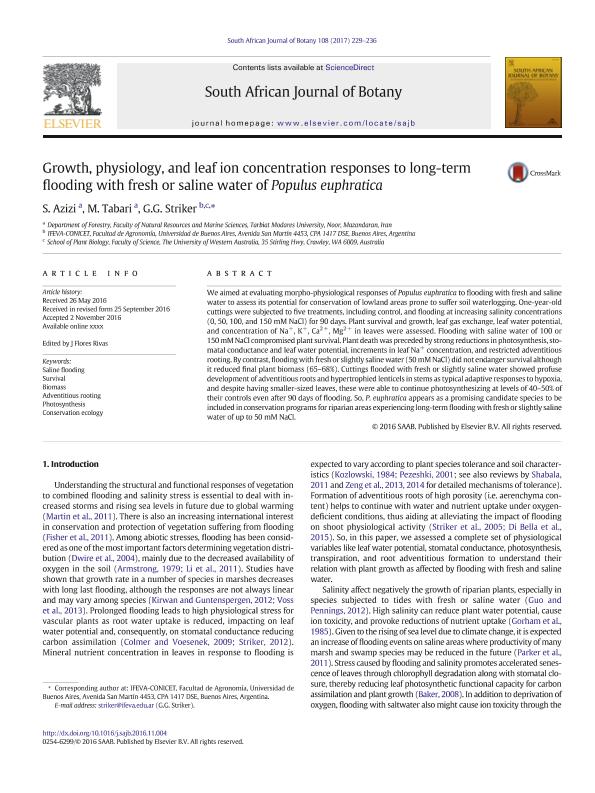Mostrar el registro sencillo del ítem
dc.contributor.author
Azizi, S.
dc.contributor.author
Tabari, M.
dc.contributor.author
Striker, Gustavo Gabriel

dc.date.available
2018-08-21T14:48:40Z
dc.date.issued
2017-01
dc.identifier.citation
Azizi, S.; Tabari, M.; Striker, Gustavo Gabriel; Growth, physiology, and leaf ion concentration responses to long-term flooding with fresh or saline water of Populus euphratica; Elsevier Science; South African Journal Of Botany; 108; 1-2017; 229-236
dc.identifier.issn
0254-6299
dc.identifier.uri
http://hdl.handle.net/11336/56313
dc.description.abstract
We aimed at evaluating morpho-physiological responses of Populus euphratica to flooding with fresh and saline water to assess its potential for conservation of lowland areas prone to suffer soil waterlogging. One-year-old cuttings were subjected to five treatments, including control, and flooding at increasing salinity concentrations (0, 50, 100, and 150 mM NaCl) for 90 days. Plant survival and growth, leaf gas exchange, leaf water potential, and concentration of Na+, K+, Ca2 +, Mg2 + in leaves were assessed. Flooding with saline water of 100 or 150 mM NaCl compromised plant survival. Plant death was preceded by strong reductions in photosynthesis, stomatal conductance and leaf water potential, increments in leaf Na+ concentration, and restricted adventitious rooting. By contrast, flooding with fresh or slightly saline water (50 mM NaCl) did not endanger survival although it reduced final plant biomass (65–68%). Cuttings flooded with fresh or slightly saline water showed profuse development of adventitious roots and hypertrophied lenticels in stems as typical adaptive responses to hypoxia, and despite having smaller-sized leaves, these were able to continue photosynthesizing at levels of 40–50% of their controls even after 90 days of flooding. So, P. euphratica appears as a promising candidate species to be included in conservation programs for riparian areas experiencing long-term flooding with fresh or slightly saline water of up to 50 mM NaCl.
dc.format
application/pdf
dc.language.iso
eng
dc.publisher
Elsevier Science

dc.rights
info:eu-repo/semantics/openAccess
dc.rights.uri
https://creativecommons.org/licenses/by-nc-sa/2.5/ar/
dc.subject
Adventitious Rooting
dc.subject
Biomass
dc.subject
Conservation Ecology
dc.subject
Photosynthesis
dc.subject
Saline Flooding
dc.subject
Survival
dc.subject.classification
Agricultura

dc.subject.classification
Agricultura, Silvicultura y Pesca

dc.subject.classification
CIENCIAS AGRÍCOLAS

dc.title
Growth, physiology, and leaf ion concentration responses to long-term flooding with fresh or saline water of Populus euphratica
dc.type
info:eu-repo/semantics/article
dc.type
info:ar-repo/semantics/artículo
dc.type
info:eu-repo/semantics/publishedVersion
dc.date.updated
2018-08-16T15:10:35Z
dc.journal.volume
108
dc.journal.pagination
229-236
dc.journal.pais
Países Bajos

dc.journal.ciudad
Amsterdam
dc.description.fil
Fil: Azizi, S.. Tarbiat Modares University; Iraq
dc.description.fil
Fil: Tabari, M.. Tarbiat Modares University; Iraq
dc.description.fil
Fil: Striker, Gustavo Gabriel. Consejo Nacional de Investigaciones Científicas y Técnicas. Oficina de Coordinación Administrativa Parque Centenario. Instituto de Investigaciones Fisiológicas y Ecológicas Vinculadas a la Agricultura. Universidad de Buenos Aires. Facultad de Agronomía; Argentina. University of Western Australia; Australia
dc.journal.title
South African Journal Of Botany

dc.relation.alternativeid
info:eu-repo/semantics/altIdentifier/doi/https://dx.doi.org/10.1016/j.sajb.2016.11.004
dc.relation.alternativeid
info:eu-repo/semantics/altIdentifier/url/https://www.sciencedirect.com/science/article/pii/S0254629916305099
Archivos asociados
